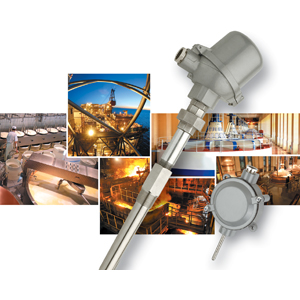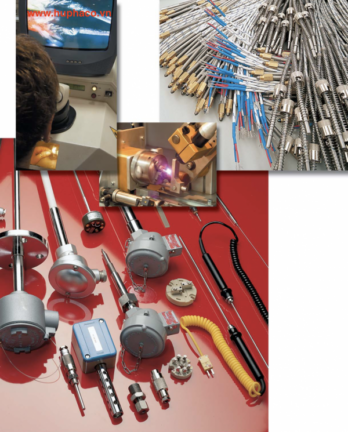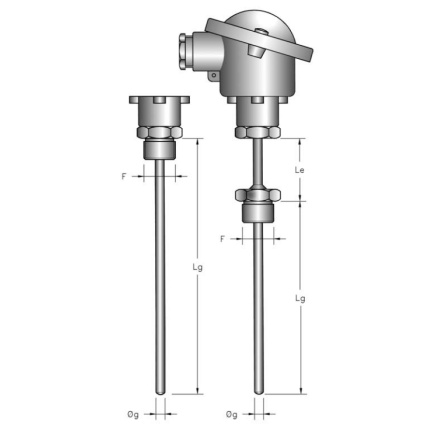Resistance thermometer pt100:
A Pt100 is a temperature-dependent resistance thermometer whose value increases with increasing temperature. This is called a positive temperature coefficient. The name Pt100 comes from the material platinum (Pt) used and the resistance value of 100 Ω at 0°C. The operating principle of metal resistance thermometers, normally called thermoresistors, is based on the variation of the electrical resistance of a metal with changes in the surrounding temperature.
Platinum and nickel are mostly used in the industrial sector, whose high resistivity and stability allow the production of thermocouples that are highly reproducible, small in size and have excellent dynamic properties.
Temperature measurements made with thermoresistors are much more accurate and reliable than those made with other types of sensors such as thermocouples.
Normally, resistance thermometers are identified by the code of the material used to make them (platinum = Pt, nickel = Ni, etc.) followed by their nominal resistance at a temperature of 0°C.
A Pt100 is a thin-layer sensor that consists of a rectangular ceramic substrate on which platinum is applied in a meandering form. The two ends of the resistor are fitted with wires and the complete sensor is given a glass protective coating. Disadvantage: Thin-layer elements such as the Pt100 are shock-sensitive due to the glass protective layer. Thin-layer elements are used in temperature measurements up to 400°C.
Wire-wound ceramic sensors consist of a ceramic base on which a platinum wire is applied. With the second external ceramic protective layer, the sensor becomes mechanically safe and also chemically resistant. Due to this construction, ceramic sensors can be used in the measuring range between -200 and 600°C. However, even a ceramic base has its weaknesses in case of vibration. Wire-wound sensors with a ceramic base are used wherever higher temperatures need to be measured, as they can be used up to 600°C.
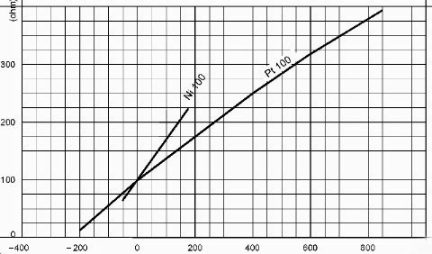
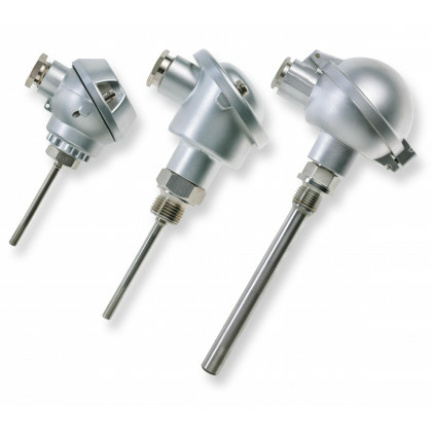
There are several methods for connecting resistance thermometers to the measuring devices. The choice of one method over another depends mainly on the required precision in measurement.
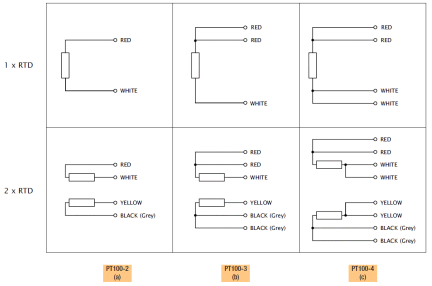
Resistance thermometers joining techniques:
A) 2-wire
B) 3-wire
C) 4-wire
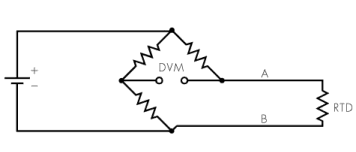 2-wire connection
2-wire connection
The two-wire technique is the least precise and is used only in cases where the connection of the thermoresistor is carried out with short and low resistance wires. When testing the equivalent electrical circuit, it can be noted that the measured electrical resistance is the sum of that of the sensitive element (and therefore depends on the temperature to be measured) and the resistance of the conductors used for the connection. The error introduced in this type of measurement is not constant: it depends on the temperature.
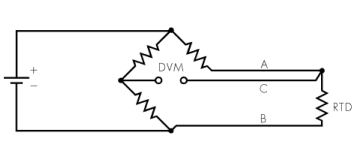 3-wire connection
3-wire connection
Thanks to the good degree of accuracy that can be obtained with measurements, the three-wire technique is most commonly used in the industrial sector. In this measuring technique, the errors caused by the resistance of the conductors used to connect the thermistor are eliminated; at the output of the measuring bridge, the voltage present depends entirely on the variation of the resistance of the resistance thermometer and, therefore, solely on temperature.
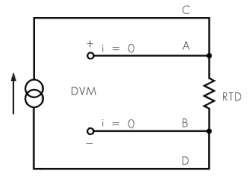 4-wire connection
4-wire connection
The volt-ampere meter four-wire technique offers the greatest possible precision; it is used little in the industrial sector and almost exclusively in laboratory environments. In an equivalent electrical circuit, it can be seen that the measured voltage depends solely on the resistance of the thermocouple; the precision of the measurement depends solely on the stability of the measuring current and the accuracy of the voltage measurement across the thermocouple.
Thermocouples:
Application at high vibration loads and higher temperature ranges from 400°C and up.
A thermocouple consists of two different electroconducting materials with different positions on the thermoelectric chain. When these are connected at one point and this point has a different temperature than the connection point, a voltage is generated that depends on the temperature difference.
Conclusion: Although thermocouples are the better choice in vibrations, however, Pt100s have higher absolute accuracy and long-term stability is also better.
Main causes of errors in measurements with thermoresistors:
Measuring temperature with thermoresistors is fairly simple compared to using other types of sensors, but certain steps must be taken to correct any measurement errors. There are three main causes of errors introduced in temperature measurements with thermoresistors:
- Fault due to self-heating of the sensitive element
- Fault due to poor electrical insulation of the sensitive element
- Error because the sensitive element is not immersed to a sufficient depth

The sensitive element heats itself during measurement when it is crossed by excessive current, which increases the temperature of the element due to the Joule effect. The temperature rise depends both on the type of sensitive element used and the measurement conditions. At the same temperature, the same thermoresistor will heat itself less if placed in water instead of air; this is because water has a higher coefficient of dispersion than air. Normally, all measuring devices that use thermoresistors as sensors have an extremely low measuring current, but it is advisable never to exceed a measuring current of 1 mA (EN 60751).
For a correct measurement with thermoresistors, it is very important that the electrical insulation between the conductors and the outer jacket is sufficiently large, especially at high temperatures. The insulation resistance can be seen as an electrical resistance parallel to that of the sensitive element. So it is clear that at a constant temperature, if the electrical insulation decreases, the voltage measured across the sensitive element will also decrease, introducing an error in the measurement. The insulation resistance may decrease when the probe is used at excessively high temperatures, with strong vibrations, or due to the influence of physical or chemical agents.
The immersion depth of the sensitive element is also very important for correct measurements; unlike thermocouples where measurements can be considered point-like, an insufficient depth can cause errors in the measurement of up to several degrees °C. This is because the sheath, usually metal, which protects the sensitive element, dissipates heat in proportion to the temperature difference between the hot and cold regions; we therefore have a thermal gradient along part of the length of the sheath. The dipping depth must therefore be sufficient so that the sensitive element within the sheath is not exposed to this thermal gradient. The minimum depth will depend on the physical measurement conditions and the dimensions of the thermoresistor (length of the element, etc.).

